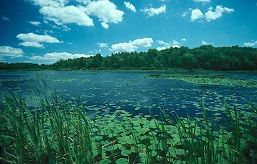Huiras Lake
No. 353

Photo by Thomas A. Meyer/DNR
Huiras Lake features a 26-acre pristine, hard water seepage lake with an undeveloped shoreline contained within a larger wooded matrix. Plant communities include dry-mesic forest, mixed conifer and hardwood swamp and a relict kettle bog. Located within a lowland hardwood swamp of black ash, the open water of the bog is surrounded by a narrow band of sphagnum moss and cat-tails and grades into shrub-carr and a tamarack-white cedar swamp. Several white pines are present and poison sumac is scattered throughout. Species include round-leaved sundew, pitcher plant, leather-leaf, huckleberry, small cranberry, round-leaved shinleaf, bog St. John's wort and bogbean.
Surrounding the eastern edge of the lake are extensive forested wetlands dominated by black ash, green ash, red maple, silver maple, yellow birch, paper birch and basswood. Near the lake large tamarack and white cedar are co-dominant and the ground layer is patchy to continuous with a good diversity of both southern and northern species including Canada mayflower, yellow bluebead-lily, jack-in-the-pulpit and marsh fern. Pockets of mature mesic hardwoods with sugar maple, beech, red oak, basswood and white pine are found to the south. The lush growth of emergent vegetation and partial seclusion make this an excellent waterfowl nesting and migration site. Additionally, the undeveloped nature of the site and its location within a rapidly urbanizing area make this site a highly valuable waterfowl and wildlife habitat in the southeastern portion of Wisconsin. Huiras Lake is owned by Restoring Lands and DNR. It was designated a State Natural Area in 2002.
Very few State Natural Areas have public facilities, but nearly all are open for a variety of recreational activities as indicated below. Generally, there are no picnic areas, restrooms, or other developments. Parking lots or designated parking areas are noted on individual SNA pages and maps. If a developed trail is present, it will normally be noted on the SNA map and/or under the Maps tab. A compass, topographic map, or GPS unit are useful tools for exploring larger, isolated SNAs.
The good majority of SNAs are isolated and have few or no facilities. Some SNAs have vehicle access lanes or parking lots, but their accessibility may vary depending on weather conditions. Parking lots and lanes are not plowed during winter. Hiking trails may be nonexistent or consist of undeveloped footpaths. A GPS unit or compass and a detailed topographic map are valuable tools for exploring larger SNAs.
Hunting and trapping
This SNA has multiple landowners. Opportunities for hunting and trapping depend on the landowner. In general, most DNR-owned land allows hunting and trapping. Partner-owned land may have other rules (for example, university-owned lands do not allow hunting or trapping). Please contact them directly to find out about their rules for hunting and trapping. You can find a link to other owner websites under the Resources tab.
Visit the Restoring Lands website for hunting opportunities on their property. DNR lands are open for hunting.
Allowable activities: DNR-owned land
The activities listed below are generally allowed on all DNR-owned SNA lands. Exceptions to this list of public uses, such as SNAs closed to hunting, are noted above and posted with signs on the property site.
- Hiking
- Fishing
- Cross country skiing
- Hunting
- Trapping
- Scientific research (permit required [PDF])
- Outdoor education
- Wild edibles (What is this?)
- Pets (Rules)
- Wildlife viewing
Prohibited activities: all SNAs
- Camping and campfires
- Collecting of animals (other than legally harvested species), non-edible fungi, rocks, minerals, fossils, archaeological artifacts, soil, downed wood, or any other natural material, alive or dead.
- Collecting for scientific research requires a permit issued by the DNR
- Collecting of plants including seeds, roots or other non-edible parts of herbaceous plants such as wildflowers or grasses
- Geocaching
- Horseback riding
- Rock climbing
- Vehicles, including bicycles, ATVs, aircraft, and snowmobiles except on trails and roadways designated for their use.
For rules governing state-owned SNAs and other state lands, please consult Chapter NR 45 Wis. Admin. Code.
Location
Ozaukee County. T12N-R21E, Section 9. 198 acres.
Driving directions
From the intersection of County Highways Z and I in Waubeka, go north on I for 2.4 miles, then west and north on Clover Valley Road for 0.3 miles to a pull-off where the road turns north. Walk south through the field to Huiras Lake.
The DNR's state natural areas program is comprised of lands owned by the state, private conservation organizations, municipalities, other governmental agencies, educational institutions and private individuals. While the majority of SNAs are open to the public, access may vary according to individual ownership policies. Public use restrictions may apply due to public safety, or to protect endangered or threatened species or unique natural features. Lands may be temporarily closed due to specific management activities.
Users are encouraged to contact the landowner for more specific details. The data shown on these maps have been obtained from various sources, and are of varying age, reliability, and resolution. The data may contain errors or omissions and should not be interpreted as a legal representation of legal ownership boundaries. To create your custom map where you can zoom to a specific location, please use the DNR's Mapping Application.
Huiras Lake is owned by Restoring Lands and the Wisconsin DNR.
